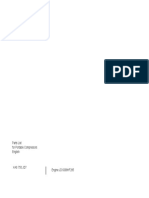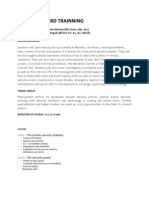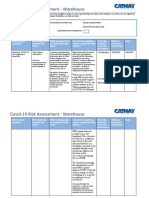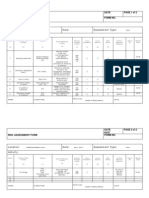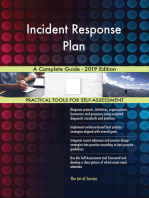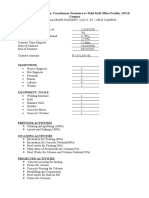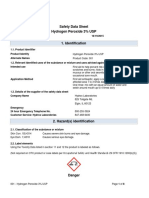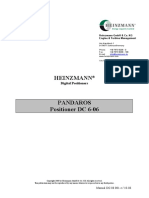Manpower Performance and Security Policy
Manpower Performance and Security Policy
Uploaded by
KesMercadoCopyright:
Available Formats
Manpower Performance and Security Policy
Manpower Performance and Security Policy
Uploaded by
KesMercadoOriginal Title
Copyright
Available Formats
Share this document
Did you find this document useful?
Is this content inappropriate?
Copyright:
Available Formats
Manpower Performance and Security Policy
Manpower Performance and Security Policy
Uploaded by
KesMercadoCopyright:
Available Formats
MANPOWER SITE PERFORMACE/SECURITY POLICY
Construction sites are easy targets for the opportunist thief; the high value of plant and equipment can
lead to quick and easy profit for the successful thief. Depending on locality, each site will have its own
issues of concern. Construction sites are subject to a number of threats, against which security should
be applied by the site operator. These include theft, vandalism and deliberate damage to company
equipment. Manpower performance also dictates the output of the project.
SCOPE
- These guidelines are designed to provide site managers and operators with an overview of
the common considerations of risk assessments and security measures to be taken into
account on construction sites. It is not intended to be a detailed manual, but should be used
to help frame thinking about security and to outline the process to follow in preparing risk
assessments and the necessary mitigation measures to be taken.
TERMS AND DEFINITIONS
o Event - Occurrence or a change in a particular set of circumstances
o Guard Force - The term guard force in this document refers to the people with the
responsibility for protecting the site. On a larger site this may be a permanent
contingent of guards.
o Hazard - An event with negative consequences, brought about through natural,
environmental or non-malicious human intent (e.g. flooding).
o Risk - A threat or hazard assessed for likelihood and impact.
o Threat - An event with negative consequences, brought about through malicious human
intent.
RISK ANALYSIS
Risk Score Categorization Notes
0-1 White No significant risk
2-4 Green Low risk
5-10 yellow Medium risk – should be
mitigated
10 + Red High risk – must be mitigated
TYPICAL Threats for construction site
o Material Pilferage
o Absenteeism
o Laziness/Tardiness
o Poor workmanship
o Disrespect to authority (Foreman, Site Supervisor)
o Being Late
o Refusal to Instruction during work hours
o Etc.…,
MITIGATION
- Once raw risks are assessed and categorized in order of severity in the raw risk register,
mitigation should be applied. Broadly, mitigation may take three forms:
o Ignore / Accept
o Export / Transfer
o Address
Ignoring - a risk is sometimes appropriate, where the cost (in terms of financial or
resource exposure) of any mitigation exceeds the impact of the event which defines the
risk. Risks should only be ignored, however, after careful analysis of mitigation cost and
impact. Ignoring a risk means that no action is taken to counter it but does not mean it
is forgotten
Exporting - a risk can be performed through insurance or contracting of a third party to
deliver mitigation. While this is entirely sensible, for example, where this can be done
for the expenditure of less resource than if directly mitigated by the operator or
manager, it is important to remember that this does not export responsibility for, or
ownership of, the risk, but merely for its management. This presents a risk in itself, in
that management of the risk falls mainly outside of the control of the operator or
manager.
Addressing - a risk is the application of mitigation measures directly by the operator or
manager. Generally, this will involve the application of people, processes or technology
to an issue to reduce the impact or the likelihood (or, ideally, both) of a risk, in order to
bring its rating down to below the operator or manager’s risk appetite. This document
necessarily concentrates on direct addressing of the risk.
MITIGATION STRATEGIES
A. DISCIPLINARY ACTIONS
a. 1st offense – verbal warning
b. 2nd offense – written warning
c. 3rd offense – 3 days suspension without pay
d. 4th offense – termination
You might also like
- Pakyaw RatesDocument36 pagesPakyaw RatesKesMercado89% (9)
- Ralco MT - R - 221 - 000 - 0 - ACS000-A - DHHS - 0 - EDocument208 pagesRalco MT - R - 221 - 000 - 0 - ACS000-A - DHHS - 0 - EBrian Hunter100% (2)
- 1310 3012 46 - XAS750Jd PartesDocument78 pages1310 3012 46 - XAS750Jd PartesFranz JW MontezaNo ratings yet
- BS 5306-3-2017 Fire Extinguishing Installtions and Equipment On PremisesDocument68 pagesBS 5306-3-2017 Fire Extinguishing Installtions and Equipment On PremisesGavinNo ratings yet
- PC12R 8Document355 pagesPC12R 8Poo100% (1)
- Disbursement Voucher: Teravera CorporationDocument1 pageDisbursement Voucher: Teravera CorporationKesMercadoNo ratings yet
- Bituminous Concrete Surface Wearing Course, Hot-Laid, 50mm THKDocument3 pagesBituminous Concrete Surface Wearing Course, Hot-Laid, 50mm THKKesMercado100% (2)
- Request Letter For Purchase of EquipmentDocument1 pageRequest Letter For Purchase of EquipmentKesMercado100% (4)
- Emergency Lighting Completion CertificateDocument13 pagesEmergency Lighting Completion CertificateKuljinder VirdiNo ratings yet
- IN-SITE: Keys to an Effective Site Safety and Security ProgramFrom EverandIN-SITE: Keys to an Effective Site Safety and Security ProgramNo ratings yet
- 11 Security OrganisationsDocument21 pages11 Security OrganisationsZoltan Nagy0% (1)
- 9.risk Assessment - Working in PantryDocument2 pages9.risk Assessment - Working in PantryManzur AhmadNo ratings yet
- G7 Draft Guidelines On Event SecurityDocument4 pagesG7 Draft Guidelines On Event SecurityDeil L. NaveaNo ratings yet
- RISK Assement AGE - Maintenance of SOD Sapin Uae-18-8-2023Document7 pagesRISK Assement AGE - Maintenance of SOD Sapin Uae-18-8-2023arabiangulfdoorest2008No ratings yet
- Syllabus For The Trade of Security Guard PDFDocument24 pagesSyllabus For The Trade of Security Guard PDFabhi13No ratings yet
- Module 3 Workshop 2 Risk Assessment Public Service Continuity 2019 MACCODocument15 pagesModule 3 Workshop 2 Risk Assessment Public Service Continuity 2019 MACCOGhia PornillosNo ratings yet
- Security Supervisor 20210630113021Document3 pagesSecurity Supervisor 20210630113021Handson makuraNo ratings yet
- 15 Physical Security Final RedactedDocument24 pages15 Physical Security Final RedactedSyed AhamedNo ratings yet
- Physical Security Training - Center For Development of Security ExcellenceDocument58 pagesPhysical Security Training - Center For Development of Security Excellenceismailov25No ratings yet
- Generic Risk Assessment: Working in Offices and Low Risk AreasDocument4 pagesGeneric Risk Assessment: Working in Offices and Low Risk AreasWisnu KertaningnagoroNo ratings yet
- Risk AssessmentDocument62 pagesRisk AssessmentAli ImamNo ratings yet
- Manual Handling Risk AssessmentDocument21 pagesManual Handling Risk Assessmentremember100% (1)
- Safety System 4Document61 pagesSafety System 4Daniel Sherom FernandoNo ratings yet
- Health and Safety Management in HealthcareDocument6 pagesHealth and Safety Management in HealthcareDr.ManageNo ratings yet
- Security Management - Hse Level 3Document16 pagesSecurity Management - Hse Level 3Emmanuel AdenolaNo ratings yet
- Workplace ViolenceDocument27 pagesWorkplace Violencealit2No ratings yet
- Industry Circular: 06 August 2014Document6 pagesIndustry Circular: 06 August 2014Abongile PhinyanaNo ratings yet
- Performance Evaluation Form: Employee Name: Department: Location: Title: Performance Period: ManagerDocument4 pagesPerformance Evaluation Form: Employee Name: Department: Location: Title: Performance Period: ManagerMarjonNo ratings yet
- Job Hazard Analysis ProcedureDocument2 pagesJob Hazard Analysis Procedureleojay24No ratings yet
- 2021-2022physical SecurityDocument30 pages2021-2022physical SecurityJoseMelarte GoocoJr.No ratings yet
- Rakshak TrainingDocument25 pagesRakshak TrainingavaduttahariNo ratings yet
- 2.4.2 Site Security Management PlanDocument1 page2.4.2 Site Security Management PlanAkbar AsyisyamNo ratings yet
- Learner GuideDocument38 pagesLearner GuidehyagiyahNo ratings yet
- Crowd Control Plan FormDocument3 pagesCrowd Control Plan FormMohsin100% (1)
- Advanced Certificate in Security ManagementDocument3 pagesAdvanced Certificate in Security Management360 BSI100% (1)
- OSHP Use of Force PolicyDocument7 pagesOSHP Use of Force PolicyReba ChenowethNo ratings yet
- IsmDocument8 pagesIsmALLYZA ROSE DE CLARONo ratings yet
- Physical Security Policy FawwazDocument13 pagesPhysical Security Policy Fawwazislam108No ratings yet
- Incident / Hazard Report Form: 1. Person Involved Details - Forward To Your Team Leader / Manager Within 24 HoursDocument3 pagesIncident / Hazard Report Form: 1. Person Involved Details - Forward To Your Team Leader / Manager Within 24 HourstitaandientiNo ratings yet
- Sample Security Manual 2020Document37 pagesSample Security Manual 2020mohosin.coatsNo ratings yet
- Euc CCTV PolicyDocument4 pagesEuc CCTV Policy.No ratings yet
- Security Guard TrainningDocument3 pagesSecurity Guard TrainningBhodzaNo ratings yet
- When You Travel, Plan Ahead!: States)Document16 pagesWhen You Travel, Plan Ahead!: States)Amir Aznan100% (1)
- SP02508 Sigma Designs Security2 Command Class v2 Commercial in Confidence RemovedDocument22 pagesSP02508 Sigma Designs Security2 Command Class v2 Commercial in Confidence RemovedHarish KumarNo ratings yet
- Lufkin Incident Management System Written ProgramDocument12 pagesLufkin Incident Management System Written ProgramMahmoud T' KantonaNo ratings yet
- Physical Security Professional PSPDocument5 pagesPhysical Security Professional PSPAli AbidiNo ratings yet
- Sia Security at EventsDocument29 pagesSia Security at EventsSaidEtebbaiNo ratings yet
- Corporate Security DirectorDocument2 pagesCorporate Security Directorapi-121431021No ratings yet
- Training Program The Security & Safety in Oil FirmsDocument7 pagesTraining Program The Security & Safety in Oil FirmstetoNo ratings yet
- Annual Security Refresher BRIEFING354Document25 pagesAnnual Security Refresher BRIEFING354Ángela RomeroNo ratings yet
- CCTV Surveillance - SOP 01 - Closed Circuit Television System (CCTV)Document7 pagesCCTV Surveillance - SOP 01 - Closed Circuit Television System (CCTV)Harshaka DineshNo ratings yet
- Environmental Safety: Topic: Duration: 120 MinutesDocument43 pagesEnvironmental Safety: Topic: Duration: 120 MinutesJohn Paul BañariaNo ratings yet
- Discpline and Salutes TrainingDocument3 pagesDiscpline and Salutes Trainingkenshi maddNo ratings yet
- Emergency Response PlanDocument27 pagesEmergency Response PlanCahyo Ambarwoko100% (1)
- Security Guideline: Standard Operating Procedures (Sop)Document2 pagesSecurity Guideline: Standard Operating Procedures (Sop)ppdanjungtp0% (1)
- Security Awarenes SeminarDocument32 pagesSecurity Awarenes Seminarmark perdon100% (2)
- All The Private Security Agencies (Who Have Been Issued License)Document6 pagesAll The Private Security Agencies (Who Have Been Issued License)Pradeep PanigrahiNo ratings yet
- Covid-19 RiskAssessmentWarehouseDocument11 pagesCovid-19 RiskAssessmentWarehouseBalgo BalgobinNo ratings yet
- Caries Risk AssessmentDocument5 pagesCaries Risk Assessmentmatingin.aileen11No ratings yet
- Policy 3 Security Planning and Risk ManagementDocument19 pagesPolicy 3 Security Planning and Risk Managementmani.babaaliNo ratings yet
- Risk Assessment Abracadabra HotelDocument2 pagesRisk Assessment Abracadabra HotelProsenjit76100% (1)
- Mall Managent and SecurityDocument20 pagesMall Managent and SecurityKumaran SgNo ratings yet
- Security and The Lodging Industry-: Ishie Mae Marie A. Kirong HM1-103 Fundamentals in Lodging OperationsDocument6 pagesSecurity and The Lodging Industry-: Ishie Mae Marie A. Kirong HM1-103 Fundamentals in Lodging OperationsIshie Mae Marie Kirong100% (1)
- Workplace Security Checklistx4Document3 pagesWorkplace Security Checklistx4Jennifer SheltonNo ratings yet
- Lea 3Document54 pagesLea 3Desiree Ann TaguibaoNo ratings yet
- Risk ASSESSMENTDocument7 pagesRisk ASSESSMENTSameer Abdul RaufNo ratings yet
- Security Awareness Programs A Complete Guide - 2019 EditionFrom EverandSecurity Awareness Programs A Complete Guide - 2019 EditionNo ratings yet
- Proposed Gen-Set House, Transformer Enclosure W/ Field Staff Office Facility, UPLB CampusDocument4 pagesProposed Gen-Set House, Transformer Enclosure W/ Field Staff Office Facility, UPLB CampusKesMercadoNo ratings yet
- Sub-Total 5,000.00: NO. Description Unit Quantity Unit Cost Total CostDocument2 pagesSub-Total 5,000.00: NO. Description Unit Quantity Unit Cost Total CostKesMercadoNo ratings yet
- Jo Request Repair of Trash TrapDocument1 pageJo Request Repair of Trash TrapKesMercadoNo ratings yet
- Sales Journal: Heavy Equipment Business UnitDocument1 pageSales Journal: Heavy Equipment Business UnitKesMercadoNo ratings yet
- Project: Location: Contractor: Contract I.D.: 19DD0380Document1 pageProject: Location: Contractor: Contract I.D.: 19DD0380KesMercadoNo ratings yet
- 19DD0137Document2 pages19DD0137KesMercadoNo ratings yet
- 19DD0122Document2 pages19DD0122KesMercadoNo ratings yet
- Sample Letter of TerminationDocument2 pagesSample Letter of TerminationKesMercadoNo ratings yet
- Worker's Decorum and Safety Rules and RegulationsDocument2 pagesWorker's Decorum and Safety Rules and RegulationsKesMercadoNo ratings yet
- Pablo City, Laguna Is Currently Employed With Teravera Corporation, Located at Lipa-Alaminos RDDocument1 pagePablo City, Laguna Is Currently Employed With Teravera Corporation, Located at Lipa-Alaminos RDKesMercadoNo ratings yet
- Quotation Ma'am JaneDocument15 pagesQuotation Ma'am JaneKesMercadoNo ratings yet
- Teravera Corporation, Located at Lipa-Alaminos Rd. Brgy. San Agustin Alaminos, LagunaDocument1 pageTeravera Corporation, Located at Lipa-Alaminos Rd. Brgy. San Agustin Alaminos, LagunaKesMercadoNo ratings yet
- Mr. JoseDocument2 pagesMr. JoseKesMercadoNo ratings yet
- YCH House Rules and Conditions of WorkDocument11 pagesYCH House Rules and Conditions of WorkKesMercadoNo ratings yet
- 20DD0161 BoeDocument11 pages20DD0161 BoeKesMercadoNo ratings yet
- Subcontract Termination LetterDocument1 pageSubcontract Termination LetterKesMercadoNo ratings yet
- Republic Act No 9296Document18 pagesRepublic Act No 9296NeverSad Ej NadabarNo ratings yet
- ASTM D7625 - 10 Standard Test Method For Laboratory Determination of AbrasiveneDocument2 pagesASTM D7625 - 10 Standard Test Method For Laboratory Determination of AbrasiveneNatoya Adams0% (1)
- DM FSD GU64 Requirements For Integrated Training Management System For Food Establishments 2Document35 pagesDM FSD GU64 Requirements For Integrated Training Management System For Food Establishments 2aggronintelNo ratings yet
- Operator & Parts Manual: Serial Numbers 1010-1070Document45 pagesOperator & Parts Manual: Serial Numbers 1010-1070Євген ЗаліщукNo ratings yet
- Safe Food Handling Procedures Project 1Document5 pagesSafe Food Handling Procedures Project 1shiplusNo ratings yet
- Government of Karnataka: Citizens' CharterDocument17 pagesGovernment of Karnataka: Citizens' CharterANILNo ratings yet
- OSHA Regulations Sanitation.-1926.51Document3 pagesOSHA Regulations Sanitation.-1926.51OkayNo ratings yet
- 03 Legal ComplianceDocument7 pages03 Legal ComplianceMuhammad Shiraz KhalidNo ratings yet
- Ahmed Hamdy Process Operation Engineer1Document7 pagesAhmed Hamdy Process Operation Engineer1Ahmad HamdyNo ratings yet
- Hazard and RiskDocument23 pagesHazard and RiskRoselleAntonioVillajuanLinsangan100% (1)
- MSDS - Loctite 243Document9 pagesMSDS - Loctite 243Muhammad ShofiudinNo ratings yet
- Global Patient Safety Action Plan 2021 2030 - Third Draft - January 2021 - WebDocument109 pagesGlobal Patient Safety Action Plan 2021 2030 - Third Draft - January 2021 - WebJosianeAzolinNo ratings yet
- Safety Data Sheet Hydrogen Peroxide 3% USPDocument8 pagesSafety Data Sheet Hydrogen Peroxide 3% USPAnthoney MooreNo ratings yet
- SOP086 Training and Competency AssessmentDocument5 pagesSOP086 Training and Competency AssessmentH.Y.LNo ratings yet
- Child InjuryDocument11 pagesChild Injuryapi-437243031No ratings yet
- 0910 Bow Tie Risk Paulo RheinboltDocument20 pages0910 Bow Tie Risk Paulo RheinboltJuan JoséNo ratings yet
- Manufacturing Supervisor ResumeDocument4 pagesManufacturing Supervisor Resumee6zwz633100% (1)
- Renolin 46 Hvi MSDSDocument9 pagesRenolin 46 Hvi MSDSGaurav RanjanNo ratings yet
- MDARR No 1 First Revision November 15Document26 pagesMDARR No 1 First Revision November 15popopioNo ratings yet
- Crown CGC35S-5, CGC40S-5, CGC45S-5, CGC50C-5, CGC55C-5 Service & Maintenance ManualDocument164 pagesCrown CGC35S-5, CGC40S-5, CGC45S-5, CGC50C-5, CGC55C-5 Service & Maintenance ManualKraktovious BoonswaggleNo ratings yet
- Polyethylene Case StudyDocument14 pagesPolyethylene Case Studys_hassan_167419No ratings yet
- Water Safety For Construction Over or Near WaterDocument17 pagesWater Safety For Construction Over or Near WaterSawyu NandarNo ratings yet
- 727 User ManualDocument40 pages727 User ManualLuis MuñozNo ratings yet
- DREM - Chapter 1Document22 pagesDREM - Chapter 1cricket reviewNo ratings yet
- Heinzman DG 08 001 e Pandaros Positioner DC6 06Document96 pagesHeinzman DG 08 001 e Pandaros Positioner DC6 06RicardoNo ratings yet


